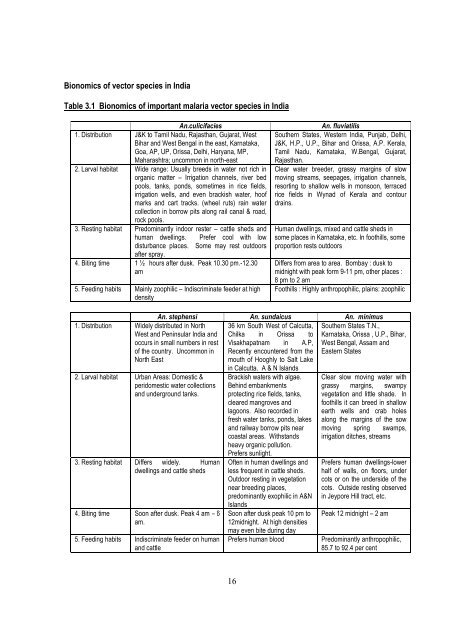training module for medical officers primary health centre - NVBDCP
training module for medical officers primary health centre - NVBDCP
training module for medical officers primary health centre - NVBDCP
- No tags were found...
Create successful ePaper yourself
Turn your PDF publications into a flip-book with our unique Google optimized e-Paper software.
Bionomics of vector species in IndiaTable 3.1 Bionomics of important malaria vector species in IndiaAn.culicifacies1. Distribution J&K to Tamil Nadu, Rajasthan, Gujarat, WestBihar and West Bengal in the east, Karnataka,Goa, AP, UP, Orissa, Delhi, Haryana, MP,Maharashtra; uncommon in north-east2. Larval habitat Wide range: Usually breeds in water not rich inorganic matter – Irrigation channels, river bedpools, tanks, ponds, sometimes in rice fields,irrigation wells, and even brackish water, hoofmarks and cart tracks. (wheel ruts) rain watercollection in borrow pits along rail canal & road,rock pools.3. Resting habitat Predominantly indoor rester – cattle sheds andhuman dwellings. Prefer cool with lowdisturbance places. Some may rest outdoorsafter spray.4. Biting time 1 ½ hours after dusk. Peak 10.30 pm.-12.30am5. Feeding habits Mainly zoophilic – Indiscriminate feeder at highdensityAn. fluviatilisSouthern States, Western India, Punjab, Delhi,J&K, H.P., U.P., Bihar and Orissa, A.P. Kerala,Tamil Nadu, Karnataka, W.Bengal, Gujarat,Rajasthan.Clear water breeder, grassy margins of slowmoving streams, seepages, irrigation channels,resorting to shallow wells in monsoon, terracedrice fields in Wynad of Kerala and contourdrains.Human dwellings, mixed and cattle sheds insome places in Karnataka, etc. In foothills, someproportion rests outdoorsDiffers from area to area. Bombay : dusk tomidnight with peak <strong>for</strong>m 9-11 pm, other places :8 pm to 2 amFoothills : Highly anthropophilic, plains: zoophilic1. Distribution Widely distributed in NorthWest and Peninsular India andoccurs in small numbers in restof the country. Uncommon inNorth East2. Larval habitat Urban Areas: Domestic &peridomestic water collectionsand underground tanks.3. Resting habitat Differs widely. Humandwellings and cattle sheds4. Biting time Soon after dusk. Peak 4 am – 6am.5. Feeding habits Indiscriminate feeder on humanand cattleAn. stephensi An. sundaicus An. minimus36 km South West of Calcutta,Chilka in Orissa toVisakhapatnam in A.P,Recently encountered from themouth of Hooghly to Salt Lakein Calcutta. A & N IslandsBrackish waters with algae.Behind embankmentsprotecting rice fields, tanks,cleared mangroves andlagoons. Also recorded infresh water tanks, ponds, lakesand railway borrow pits nearcoastal areas. Withstandsheavy organic pollution.Prefers sunlight.Often in human dwellings andless frequent in cattle sheds.Outdoor resting in vegetationnear breeding places,predominantly exophilic in A&NIslandsSoon after dusk peak 10 pm to12midnight. At high densitiesmay even bite during dayPrefers human bloodSouthern States T.N.,Karnataka, Orissa , U.P., Bihar,West Bengal, Assam andEastern StatesClear slow moving water withgrassy margins, swampyvegetation and little shade. Infoothills it can breed in shallowearth wells and crab holesalong the margins of the sowmoving spring swamps,irrigation ditches, streamsPrefers human dwellings-lowerhalf of walls, on floors, undercots or on the underside of thecots. Outside resting observedin Jeypore Hill tract, etc.Peak 12 midnight – 2 amPredominantly anthropophilic,85.7 to 92.4 per cent16
















